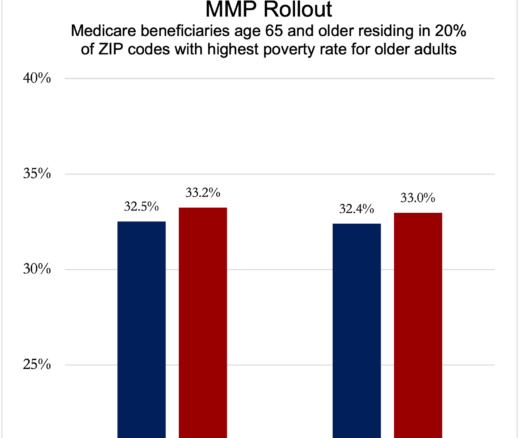
Acupuncture Could Fix America’s Chronic Pain Crisis–So Why Can’t Patients Get It?
A Proven, Low-Risk Treatment Is Backed by Major Studies and Patient Demand, Yet Medicare and Insurers Still Make It Hard To Use
In Their Own Words

Medicare and Medicaid fail to work together effectively. For the 12.5 million Americans dually enrolled in both programs, navigating a maze of jargon and bureaucratic hurdles can be a daily struggle.
These “dual enrollees” are at risk for experiencing health disparities and are burdened with more chronic conditions that require costly care. Nearly all dual enrollees have incomes below $20,000 a year, and are disproportionately people of color (What We Know About Medicare Enrollment for Dual Enrollees | Urban Institute, 2024.)
Despite their profound clinical and social needs, these beneficiaries too often experience poor coordination between these programs. It forces patients, families, and providers to navigate through conflicting policies, limiting access to appropriate, person-centered care. We need investments in care delivery innovations that provide integrated care, but we also need a clear way to pay providers for those crucial services.
The Leonard Davis Institute of Health Economics’ half-day conference, “Forging a Path: Toward Integrated Care for Dually Eligible Individuals,” at the University of Pennsylvania on July 22, 2024 focused on the problem of creating integrated care for dually insured individuals. The conference occurred while significant policies are being considered that would integrate services and spending for beneficiaries, notably The DUALS Act of 2024, sponsored by Sen. Bill Cassidy, R-LA.
While the DUALS Act wasn’t the primary focus, the goal of integrating services and understanding the perspectives of dually insured individuals was central to the event. Attendees included policymakers, academics, clinicians, and most importantly adults dually insured through Medicare and Medicaid. Through a series of keynote speakers and panel discussions, attendees received a primer on the current state of healthcare coverage for dual-eligible individuals and their unique experiences.
So confusing were the abbreviations that attendees were afforded a glossary of Integrated Models Descriptions. Terms included Fully Integrated Dual Eligible Special Needs Plans (FIDE SNPs), Highly Integrated Dual Eligible Special Needs Plans (HIDE SNPs), and more. While these integrated plans intend to align enrollment coverage for dual-eligible enrollees, there are significant concerns about unintended consequences. Chief among them is that coverage varies from state to state, raising concerns about worsening health inequities for dually enrolled individuals.
The most impactful panels included individuals who outlined many concerns about their dual coverage. They mentioned how coverage for services is often uncoordinated between the two government programs and how patients sometimes must change plans when providers drop their insurer due to Medicaid non-payment. They also mentioned hassles with pre-authorization and partial coverage of durable medical equipment.
These difficulties are complicated by a barrage of managed care plans jockeying for beneficiary enrollment, offering freebies like transportation or monthly stipends for food. Navigating care is a full-time job for dual enrollees, who often must choose between receiving a monthly stipend or potentially losing a valued provider when taking on new coverage.
Panelists expressed that for some, the risks are too high. These perspectives echoed the frustration of others who have tried to access care in this convoluted system. It’s easy to see how such a system can worsen existing health disparities.
Keynote speaker Dr. Toyin Ajayi, Co-Founder and CEO of Cityblock Health, offered some reasons for hope, highlighting the need to redesign care delivery to meet the needs of dually eligible individuals. Solutions exist, but most health systems are made for the commercial market and not for people with complex needs. Integration among payers is a worthy first step, but we need to go beyond that and create practical payment models for providers that support the type of care needed to achieve high quality.
As a director of a health system-based intervention to support care transitions for Medicaid-insured and dually eligible individuals, we see the potential for innovation and redesign in healthcare. However, the cost of sustaining evidenced-based care delivery models that may require new hires often falls on providers or systems who may not be reimbursed from payers for additional care coordination. Current policies also fail to address the need for investment or payment models that sustain system-level care integration solutions.
Care integration, often carried out by nurses and other professionals, typically occurs outside of direct patient visits in interdisciplinary team meetings. Payment reform is essential to reimburse providers for these vital coordination activities. Implementing billing codes for care coordination and creating financial incentives for providers to engage in integrated care would support the delivery of high-quality, comprehensive treatments to dually eligible patients, ensuring that their complex needs are met more effectively.
Until the coordination of care on the ground is addressed and we know who covers the cost of redesigning care delivery, true integration will remain a missing piece.



A Proven, Low-Risk Treatment Is Backed by Major Studies and Patient Demand, Yet Medicare and Insurers Still Make It Hard To Use

Chart of the Day: Medicare-Medicaid Plans—Created to Streamline Care for Dually Eligible Individuals—Failed to Increase Medicaid Participation in High-Poverty Communities
Research Brief: Shorter Stays in Skilled Nursing Facilities and Less Home Health Didn’t Lead to Worse Outcomes, Pointing to Opportunities for Traditional Medicare

How Threatened Reproductive Rights Pushed More Pennsylvanians Toward Sterilization

Abortion Restrictions Can Backfire, Pushing Families to End Pregnancies

They Reduce Coverage, Not Costs, History Shows. Smarter Incentives Would Encourage the Private Sector